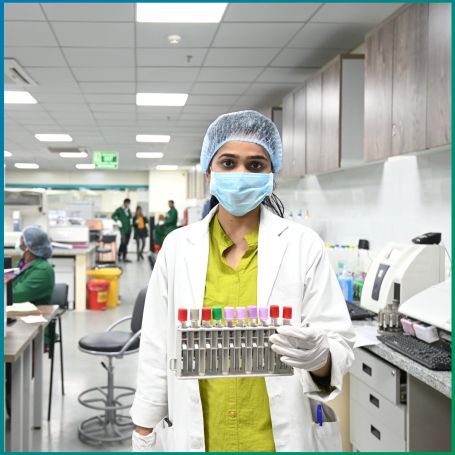
The C/S Ear Discharge Test is designed to diagnose ear infections by detecting the specific bacteria, fungi, or other microorganisms that may be present in the ear discharge.

The C/S Ear Discharge Test is a diagnostic procedure used to identify infections in the ear canal, especially when there is an abnormal discharge, also known as otorrhea. The test involves collecting a sample of the ear discharge and sending it to a laboratory for culture (to grow and identify any microorganisms) and sensitivity testing (to determine the most effective antibiotic or antifungal treatment). It is an essential diagnostic tool for determining the underlying cause of ear infections and guiding the appropriate treatment, ensuring that patients recover effectively and avoid complications.
1] Accurate Diagnosis - The C/S Ear Discharge Test is critical for determining the exact cause of ear infections. Many different pathogens can cause ear infections, including bacteria (like Pseudomonas aeruginosa and Streptococcus pneumoniae), fungi (such as Aspergillus and Candida species), and viruses. Identifying the correct pathogen is key to choosing the right treatment, especially in cases of chronic or recurrent infections.
2] Guiding Treatment - One of the key benefits of the C/S Ear Discharge Test is its ability to provide antibiotic or antifungal sensitivity information. By testing the cultured microorganisms against different drugs, the laboratory can determine which antibiotics or antifungal agents are most effective. This helps doctors choose the most appropriate treatment, which can result in faster recovery, reduced risk of complications, and fewer side effects.
3] Managing Chronic or Recurrent Infections - For individuals with chronic or recurrent ear infections, the C/S Ear Discharge Test can help identify any resistant bacteria or fungi that may require more specialized treatment. In these cases, standard treatments might not be effective, and the sensitivity results from the test can guide the use of more potent medications.
4] Preventing Complications - Untreated ear infections can lead to serious complications such as hearing loss, eardrum perforation, or spread of the infection to surrounding tissues, including the skull and brain. Early and accurate identification of the infection through a C/S Ear Discharge Test helps prevent these complications by ensuring the correct treatment is started promptly.
1] Sample Collection - The test begins with the collection of a sample from the ear discharge, which is typically done by a healthcare provider. The patient’s ear is examined to assess the amount and type of discharge. A sterile swab is used to collect a sample of the discharge from the ear canal. In some cases, if the ear discharge is thick or pus-filled, a small sample may be aspirated with a sterile syringe.
2] Transporting the Sample - Once the sample is collected, it is sent to a laboratory for analysis. The sample should be transported under sterile conditions to prevent contamination, and it is usually processed within a few hours to ensure optimal results.
3] Culturing the Sample - In the laboratory, the sample is cultured on a medium that encourages the growth of bacteria, fungi, or other pathogens. The sample is incubated at an appropriate temperature, and over the next 24 to 48 hours, any microorganisms present in the sample will grow into colonies.
4] Identifying the Pathogen - After the culture period, the colonies of microorganisms are examined and identified based on their appearance, biochemical properties, and sometimes through molecular techniques. Once the pathogen is identified, it is tested for its susceptibility to various antibiotics or antifungal drugs.
5] Sensitivity Testing - Sensitivity testing is performed by exposing the isolated pathogen to different antibiotics or antifungal agents. The lab will determine which drugs are effective at inhibiting the growth of the microorganism, guiding the doctor in selecting the best treatment.
6] Result Interpretation - The results of the C/S Ear Discharge Test typically take 48 to 72 hours. A positive result indicates an infection, and the doctor will use the sensitivity data to prescribe the appropriate medication. A negative result suggests no active infection, but further evaluation may be needed if symptoms persist.
Choosing best pathology lab near me for the C/S Ear Discharge Test ensures accurate, timely, and reliable results for diagnosing ear infections. Diagnopein uses advanced diagnostic techniques and a state-of-the-art laboratory to culture ear discharge samples and identify the exact pathogens responsible for the infection. Their comprehensive sensitivity testing helps guide clinicians in selecting the most effective antibiotics or antifungal treatments, ensuring targeted therapy and faster recovery. With a commitment to precision, Diagnopein minimizes the risk of incorrect diagnoses or ineffective treatments, making it an ideal choice for healthcare providers looking to manage ear infections efficiently. Additionally, Diagnopein offers quick turnaround times, excellent customer service, and a reputation for accuracy, making it a trusted partner for diagnosing ear-related conditions.
1. Culture Method
2. Sample
3. Colony Count
4. Organism(s) Isolated
5. Culture Report: Culture yields growth of
6. Culture isolated after 7 days :
7. Culture isolated after 14 days:
8. Culture isolated after 21 days:
9. Ampicillin
10. Amikacin
11. Amoxicillin clavulanate
12. cefoperazon+sulbactam
13. Cefuroxime
14. Cefepime
15. Cefotaxime
16. Ciprofloxacin
17. Ertapenem
18. Gentamicin
19. Imipenem
20. Meropenem
21. Norfloxacin
22. Nitrofurantoin
23. Piperacillin-tazobactam
24. Trimethoprim-Sulfamethoxazole (Cotrimoxazole)
25. Clindamycin
26. Erythromycin
27. Linezolid
28. Levofloxacin
29. Penicillin
30. Tigecycline
31. Teicoplanin
32. Vancomycin
No, the test is minimally invasive. It involves collecting a small sample of ear discharge with a sterile swab, which is generally not painful.
The test can detect bacterial, fungal, or viral infections in the ear, such as otitis externa (swimmer’s ear), otitis media, and fungal infections caused by Aspergillus or Candida.
A positive result indicates the presence of infection, and the test will identify the causative pathogen and its sensitivity to specific antibiotics or antifungal treatments.
A healthcare provider collects a sample from the ear discharge using a sterile swab, which is then cultured in a laboratory to identify microorganisms and test their sensitivity to medications.